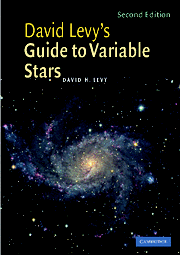Book contents
- Frontmatter
- Contents
- Foreword to the first edition
- Preface
- Acknowledgments
- Part I Getting to know the sky
- Part II Getting to know the variables
- 5 Meeting the family
- 6 Getting started with Cepheids
- 7 Algol, the demon of autumn
- 8 How to estimate a variable
- 9 Names and records
- 10 How your observations help us understand a variable star
- 11 Observing hints
- 12 Observing with CCDs
- 13 Stately and wonderful
- 14 Stars of challenge
- 15 Bright, easy, and interesting
- 16 Betelgeuse: easy and hard
- 17 Not too regular
- 18 Nova? What nova?
- 19 Supernovae
- 20 Clyde Tombaugh's star and the family of cataclysmic variables
- 21 A nova in reverse?
- 22 RU Lupi?
- 23 Orion, the star factory
- 24 Other variable things
- 25 The Sun
- Part III Suggested variables for observation throughout the year
- Part IV A miscellany
- Index
22 - RU Lupi?
from Part II - Getting to know the variables
Published online by Cambridge University Press: 05 August 2012
- Frontmatter
- Contents
- Foreword to the first edition
- Preface
- Acknowledgments
- Part I Getting to know the sky
- Part II Getting to know the variables
- 5 Meeting the family
- 6 Getting started with Cepheids
- 7 Algol, the demon of autumn
- 8 How to estimate a variable
- 9 Names and records
- 10 How your observations help us understand a variable star
- 11 Observing hints
- 12 Observing with CCDs
- 13 Stately and wonderful
- 14 Stars of challenge
- 15 Bright, easy, and interesting
- 16 Betelgeuse: easy and hard
- 17 Not too regular
- 18 Nova? What nova?
- 19 Supernovae
- 20 Clyde Tombaugh's star and the family of cataclysmic variables
- 21 A nova in reverse?
- 22 RU Lupi?
- 23 Orion, the star factory
- 24 Other variable things
- 25 The Sun
- Part III Suggested variables for observation throughout the year
- Part IV A miscellany
- Index
Summary
Probably: and particularly if by now you are an enthusiastic observer enthralled with the antics of the stars. So let's take advantage of the situation and perambulate amongst two of the most unusual objects in our galaxy, 041619 T Tauri, and 155037 RU Lupi, two stars that represent the carefree conduct of cosmic youth. Both stars are irregular variables and represent stars that are observed in clouds of gas called diffuse nebulae.
T Tauri
Let's begin with T Tauri, the easier of the two, a star that can be watched easily from northern latitudes in the frigid evenings of winter.
If you can find the Hyades, you can find T Tauri. Moving from Delta to 64 Tauri to 4th magnitude 68 Tauri, you proceed to the northeast until you reach Epsilon Tauri, a 3.6 magnitude star (Fig. 22.1). Slightly to the southwest of Epsilon is a group of four stars in the shape of a malformed kite. I use this group as a guide to T Tauri.
Notice the magnitude range of 9.3 to 13.5; I have observed T Tauri for several years and I have never once seen it go fainter than magnitude 10.6 nor brighter than the mid 9s. Most observers have reported it hovering just brighter than 10th magnitude.
But that's only part of the story. T Tauri occasionally can flicker.
- Type
- Chapter
- Information
- David Levy's Guide to Variable Stars , pp. 131 - 134Publisher: Cambridge University PressPrint publication year: 2005

